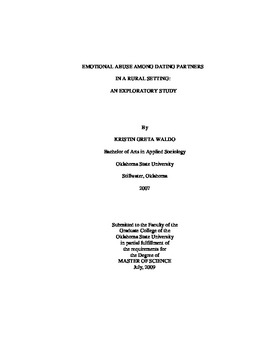| dc.contributor.author | Waldo, Kristin Greta | |
| dc.date.accessioned | 2014-04-15T22:24:21Z | |
| dc.date.available | 2014-04-15T22:24:21Z | |
| dc.date.issued | 2009-07-01 | |
| dc.identifier.uri | https://hdl.handle.net/11244/9491 | |
| dc.description.abstract | Violence against women was elevated to the level of a societal level problem through the passage of the Violence Against Women Act in 1994. The most consistent indicator of the level of violence within the United States is contained in homicide data. Inspection of data regarding female victim intimate partner homicide reveals that the rate of this type of violence has remained relatively constant since 1998. Rural areas have benefited least from federal legislation concerning violence against women. Oklahoma in particular has ranked consistently above the national average in female victim intimate partner homicide. This research explores the relationship between emotional abuse and select variables implicated in the literature in interpersonal abuse and violence. Data collected through the administration of a booklet-style, paper-and-pencil survey instrument was analyzed using OLS Multiple Regression to explore the predictive valued of select variables on predicted levels of support for hypergender ideology, respondent self-reports of dating relationship behavior, and respondent reports of perceived partner dating relationship behavior. The analyses showed predictive value of religious fundamentalism and dogmatism on levels of hypergender. Hypergender was found to be predictive of levels of respondent self-reports of dating relationship behaviors and partner dating relationship behaviors. Religious fundamentalism and dogmatism did not display the substantive effects expected, lowering reports of emotionally abusive relationship behavior. However, both religious fundamentalism and dogmatism increased the positive, substantive effect of hypergender of the reporting of relationship behaviors. Gender differences were found in the use of behaviors associated with different dimensions of emotional abuse. Gender differences were also found in the perception of partner behaviors consistent with different dimensions of emotional abuse. Locus of Control (God Control Revision), while of theoretical importance, was of no utility in this study. Further research on this measure should be undertaken. | |
| dc.format | application/pdf | |
| dc.language | en_US | |
| dc.publisher | Oklahoma State University | |
| dc.rights | Copyright is held by the author who has granted the Oklahoma State University Library the non-exclusive right to share this material in its institutional repository. Contact Digital Library Services at lib-dls@okstate.edu or 405-744-9161 for the permission policy on the use, reproduction or distribution of this material. | |
| dc.title | Emotional Abuse Among Dating Partners in a Rural Setting: An Exploratory Study | |
| dc.type | text | |
| osu.filename | Waldo_okstate_0664M_10365.pdf | |
| osu.college | Arts and Sciences | |
| osu.accesstype | Open Access | |
| dc.description.department | Department of Sociology | |
| dc.type.genre | Thesis | |
